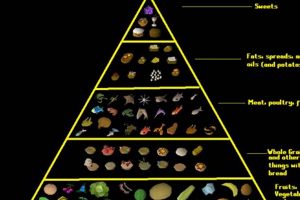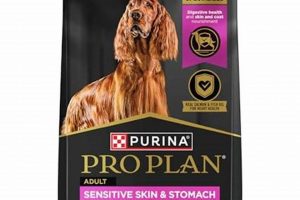Selecting optimal nourishment for a Saint Bernard is a crucial aspect of ensuring the health and longevity of this large breed. This dietary consideration involves understanding the specific nutritional requirements associated with a giant breed’s development and maintenance. An appropriate diet will support bone and joint health, muscle development, and overall vitality.
Proper nutrition provides several benefits, including maintaining a healthy weight, supporting optimal digestion, and minimizing the risk of developmental orthopedic diseases such as hip dysplasia. Historically, the understanding of canine nutritional needs has evolved considerably, moving from simple table scraps to scientifically formulated commercial diets. This evolution has led to targeted food options designed to meet the unique demands of specific breeds, including the Saint Bernard.
The following sections will explore the key components of a suitable dietary plan for Saint Bernards, covering topics such as appropriate life-stage nutrition, ingredient considerations, potential sensitivities, and optimal feeding practices. This information is intended to provide a comprehensive guide to ensure the well-being of Saint Bernards through informed dietary choices.
Dietary Recommendations for Saint Bernards
The following tips offer guidance on formulating an appropriate dietary plan, tailored to the physiological needs of Saint Bernards, focusing on optimal health outcomes.
Tip 1: Choose Age-Appropriate Food: Puppies require food formulated for large-breed puppies to control growth rate and prevent skeletal problems. Adult Saint Bernards benefit from maintenance diets, while senior dogs may need formulations addressing joint health and reduced activity levels.
Tip 2: Monitor Caloric Intake: Saint Bernards are prone to obesity. Control portion sizes and adjust feeding amounts based on activity level and body condition. Regular veterinary check-ups can help assess optimal weight maintenance.
Tip 3: Prioritize High-Quality Protein Sources: Protein is essential for muscle development and maintenance. Look for dog foods listing meat, poultry, or fish as the primary ingredient. Avoid foods heavily reliant on plant-based protein sources.
Tip 4: Include Joint-Supportive Nutrients: Consider incorporating glucosamine and chondroitin into the diet, especially for older Saint Bernards. These supplements can help support cartilage health and alleviate joint pain associated with arthritis.
Tip 5: Be Mindful of Potential Sensitivities: Saint Bernards can be prone to food allergies or sensitivities. If digestive issues or skin problems arise, consider a limited-ingredient diet or consult with a veterinarian regarding potential allergens.
Tip 6: Ensure Adequate Fiber Intake: Fiber aids in digestion and helps maintain bowel regularity. Beet pulp or other fiber sources in the diet can promote healthy digestion.
Tip 7: Divide Daily Food Ration: Feeding multiple smaller meals throughout the day can help reduce the risk of bloat (gastric dilatation-volvulus), a life-threatening condition to which Saint Bernards are predisposed.
Adhering to these recommendations will significantly contribute to the overall well-being of Saint Bernards, promoting optimal health and reducing the risk of diet-related health issues.
The subsequent section will provide concluding remarks, summarizing the key considerations for responsible dietary management of Saint Bernards.
1. Large-Breed Puppy Formula
The selection of an appropriate diet for a Saint Bernard puppy is a critical decision impacting skeletal development and overall well-being. Large-breed puppy formulas are specifically designed to address the unique nutritional needs of puppies that will mature to a significant size. These formulas differ substantially from standard puppy foods and are considered a cornerstone in providing optimal nourishment.
- Controlled Growth Rate
Large-breed puppy formulas are formulated to promote a moderate, consistent growth rate. Rapid growth, often fueled by excessive caloric intake and improper mineral balance, can increase the risk of developmental orthopedic diseases such as hip dysplasia, elbow dysplasia, and osteochondrosis dissecans (OCD). These conditions can significantly impact a Saint Bernard’s quality of life.
- Optimized Calcium-to-Phosphorus Ratio
The ratio of calcium to phosphorus is meticulously controlled in large-breed puppy formulas. Excess calcium can disrupt bone formation, leading to skeletal abnormalities. Maintaining a balanced ratio, typically between 1:1 and 2:1, is essential for proper bone development in Saint Bernard puppies. The absolute level of calcium is also carefully managed.
- Moderate Caloric Density
Large-breed puppy formulas generally have a lower caloric density compared to regular puppy foods. This helps prevent overfeeding and excessive weight gain, reducing stress on developing joints. It is vital to adhere to the feeding guidelines provided by the manufacturer and adjust portions based on individual puppy needs and activity levels.
- Adequate Protein Content
While controlling growth rate is crucial, adequate protein is still necessary for muscle development and overall health. Large-breed puppy formulas provide sufficient, high-quality protein sources to support muscle growth without contributing to excessively rapid skeletal growth. The source of protein is also a key consideration, favoring animal-based proteins over plant-based alternatives.
The correct application of these facets of large-breed puppy formulas is vital in providing optimal nourishment for Saint Bernard puppies. The controlled growth rate, optimized mineral balance, and moderate caloric density work synergistically to support healthy skeletal development and reduce the risk of orthopedic diseases, thus playing a foundational role in the long-term well-being of the breed. Careful selection and adherence to feeding guidelines are crucial in reaping the benefits of these specialized formulations.
2. Controlled Calcium Levels
The concept of controlled calcium levels is intrinsically linked to optimal nutrition for Saint Bernards, particularly during their growth phase. Excess calcium intake is a significant risk factor for developmental orthopedic diseases in large and giant breeds. These diseases, including hip and elbow dysplasia and osteochondrosis, can severely impair mobility and quality of life. Therefore, managing calcium intake within a safe and appropriate range is a cornerstone of responsible dietary management. The causal relationship is straightforward: excessive calcium consumption disrupts normal bone development processes, leading to skeletal abnormalities. The importance of controlled calcium lies in its preventive role, mitigating the risk of these debilitating conditions.
Commercial large-breed puppy foods are formulated with precise calcium levels, typically ranging from 1.1% to 1.5% on a dry matter basis. These formulations also carefully manage the calcium-to-phosphorus ratio, aiming for a balance between 1:1 and 2:1. Supplementation with calcium is generally contraindicated unless specifically directed by a veterinarian based on individual needs. Real-life examples underscore the practical significance of this understanding. Breeders and owners who adhere to these dietary guidelines often report lower incidence rates of orthopedic problems in their Saint Bernard puppies compared to those who supplement with calcium or feed inappropriately formulated diets. Regular veterinary consultations are crucial for monitoring growth and adjusting dietary strategies as needed.
In summary, maintaining controlled calcium levels represents a proactive measure in safeguarding the skeletal health of Saint Bernards. While adequate calcium is necessary for bone development, excessive intake can have detrimental effects. The practical significance of this understanding translates to selecting appropriate commercially formulated diets and avoiding unnecessary supplementation. This dietary approach, coupled with regular veterinary monitoring, offers the best chance of preventing developmental orthopedic diseases and ensuring a healthy, active life for Saint Bernards.
3. Adequate Protein Content
Adequate protein content is a non-negotiable aspect of optimal nutrition for Saint Bernards. Protein serves as the fundamental building block for muscle development, tissue repair, and various physiological processes. The direct relationship between sufficient protein intake and the health of a Saint Bernard is evident in its impact on muscle mass, immune function, and overall vitality. A deficiency can lead to muscle wasting, impaired immune response, and reduced energy levels, all of which compromise the animal’s well-being. Considering the breed’s large size and substantial muscle mass, protein requirements are inherently elevated compared to smaller breeds. The best food for Saint Bernard, therefore, must prioritize high-quality, bioavailable protein sources.
Practical examples demonstrate the importance of adequate protein. Saint Bernards engaged in regular exercise or working roles require higher protein levels to support muscle recovery and maintenance. Conversely, senior Saint Bernards may need adjusted protein levels depending on kidney function, as excessive protein can exacerbate existing kidney issues. Identifying high-quality protein sources is crucial; ingredients such as chicken, beef, fish, and eggs are generally preferred over plant-based proteins due to their superior amino acid profiles and digestibility. Lower quality food may include excessive amounts of corn or soy to boost the stated protein content, which are less bioavailable and may cause digestive distress. Careful label evaluation and veterinary consultation can aid in determining the appropriate protein source and quantity for individual needs.
In conclusion, adequate protein content is essential for maintaining the health, muscle mass, and overall well-being of Saint Bernards. Selecting a diet with high-quality, digestible protein sources and adjusting intake based on life stage and activity level is imperative. While ensuring sufficient protein, potential contraindications such as existing kidney conditions must be considered, necessitating individualized dietary strategies guided by veterinary professionals. By prioritizing protein quality and quantity, one can significantly contribute to the health and longevity of this giant breed.
4. Joint-Support Supplements
The inclusion of joint-support supplements within the dietary framework of a Saint Bernard is a proactive approach to mitigating the breed’s inherent susceptibility to joint-related ailments. Saint Bernards, due to their considerable size and rapid growth, are predisposed to conditions such as hip dysplasia, elbow dysplasia, and osteoarthritis. Joint-support supplements, primarily glucosamine and chondroitin, act as chondroprotective agents, theoretically aiding in cartilage maintenance and reducing inflammation within joint structures. While the empirical evidence supporting their efficacy is varied, anecdotal reports and some clinical studies suggest potential benefits in alleviating symptoms of joint pain and improving mobility, particularly in older dogs or those with existing degenerative joint disease. Thus, joint support is a practical significance for “best food for saint bernard”.
The integration of joint-support supplements into a Saint Bernard’s diet can take various forms. Some commercial dog foods, specifically those formulated for large breeds or senior dogs, incorporate glucosamine and chondroitin directly into their formulas. Alternatively, supplements can be administered separately as chews, tablets, or powders added to the dog’s food. Dosage and administration should adhere to veterinary recommendations, as excessive supplementation may not necessarily yield increased benefits and could potentially lead to adverse effects. Real-world observations indicate that Saint Bernards maintained on diets supplemented with glucosamine and chondroitin from a young age may exhibit greater joint flexibility and reduced signs of discomfort as they age, although definitive conclusions require controlled, long-term studies.
In summary, joint-support supplements represent a potentially valuable component of a comprehensive dietary strategy aimed at promoting joint health and mitigating the risk of degenerative joint disease in Saint Bernards. While not a guaranteed solution, their inclusion in the diet, particularly in conjunction with other preventative measures such as weight management and appropriate exercise, may contribute to improved comfort and mobility. It’s crucial to consult with a veterinarian to determine the appropriate type, dosage, and administration of joint-support supplements for each individual Saint Bernard, based on its specific needs and health status. Proper guidance is essential for ensuring that supplementation is both safe and potentially beneficial.
5. Portion Control Crucial
The designation of “Portion Control Crucial” as an integral facet of “best food for Saint Bernard” underscores the profound impact of dietary management on the breed’s health and longevity. Saint Bernards, predisposed to rapid weight gain due to their size and potential for reduced activity levels, are particularly susceptible to obesity-related health complications. These complications include, but are not limited to, orthopedic issues such as hip dysplasia and osteoarthritis, cardiovascular strain, and an increased risk of diabetes. The causal relationship is straightforward: excessive caloric intake, without commensurate energy expenditure, leads to weight gain, which then exacerbates pre-existing genetic predispositions and compromises overall physiological function. Therefore, meticulous portion control, irrespective of the specific food formulation selected, becomes paramount in mitigating these risks.
The practical implementation of portion control involves several key considerations. Firstly, accurately measuring food portions according to the manufacturer’s guidelines, adjusted for the individual dog’s age, activity level, and metabolic rate, is essential. Visual assessments of body condition, utilizing established scoring systems, should supplement these measurements to ensure that the dog maintains an ideal weight. Real-life examples illustrate the significance of this approach. Saint Bernards maintained on rigorously controlled portions, despite consuming high-quality food, exhibit a lower incidence of obesity-related health problems compared to those allowed free access to food. Moreover, dividing the daily food ration into multiple smaller meals can aid in preventing gastric dilatation-volvulus (bloat), a life-threatening condition to which the breed is prone. Veterinary consultation provides valuable guidance in determining optimal caloric needs and adjusting portion sizes accordingly.
In summary, “Portion Control Crucial” is not merely a supplementary consideration but rather a fundamental component of ensuring optimal health for Saint Bernards. The breed’s predisposition to obesity and related complications necessitates a proactive approach to dietary management, emphasizing accurate portion measurement, regular body condition assessment, and, when appropriate, dietary adjustments guided by veterinary expertise. By prioritizing portion control, owners can significantly reduce the risk of obesity-related health issues and promote a healthier, more active life for their Saint Bernard companions.
Frequently Asked Questions
This section addresses common inquiries regarding the appropriate dietary management for Saint Bernards, providing concise and informative answers to ensure optimal health and well-being.
Question 1: At what age should a Saint Bernard transition from puppy to adult food?
The transition from large-breed puppy food to adult food should occur gradually around 18-24 months of age. This timeframe allows for proper skeletal development before shifting to a maintenance diet.
Question 2: Are grain-free diets inherently superior for Saint Bernards?
Grain-free diets are not automatically superior. While some dogs may benefit due to sensitivities, grains can be a healthy source of carbohydrates. The focus should be on the overall quality of ingredients and the dog’s individual needs.
Question 3: How often should a Saint Bernard be fed per day?
Adult Saint Bernards should ideally be fed two to three smaller meals per day rather than one large meal to reduce the risk of bloat (gastric dilatation-volvulus).
Question 4: What are the potential risks of overfeeding a Saint Bernard puppy?
Overfeeding a Saint Bernard puppy can lead to excessively rapid growth, increasing the risk of developmental orthopedic diseases such as hip and elbow dysplasia.
Question 5: Are homemade diets a viable option for Saint Bernards?
Homemade diets can be viable, but they require careful planning and formulation by a veterinary nutritionist to ensure complete and balanced nutrition. Deficiencies or excesses can have serious health consequences.
Question 6: How can one determine if a Saint Bernard has a food allergy or sensitivity?
Signs of food allergies or sensitivities can include skin irritation, digestive upset, and chronic ear infections. Consultation with a veterinarian is necessary for proper diagnosis and management, potentially including elimination diets.
Understanding these key questions and answers will assist in making informed decisions about the diet of a Saint Bernard. Seeking professional veterinary advice is always recommended for personalized dietary plans.
The subsequent section will provide concluding remarks, summarizing the key considerations for responsible dietary management of Saint Bernards.
Best Food for Saint Bernard
The preceding discussion has comprehensively explored various facets of optimal nutrition for Saint Bernards. From the crucial selection of age-appropriate formulations to the significance of portion control and the potential benefits of joint-support supplements, a consistent theme has emerged: dietary management is paramount to the health and longevity of this giant breed. Careful attention to detail, informed decision-making, and adherence to veterinary recommendations are not merely suggestions but rather necessities in mitigating the risks associated with rapid growth, predisposition to orthopedic issues, and the potential for obesity.
Ultimately, responsible Saint Bernard ownership extends beyond providing affection and companionship; it encompasses a commitment to ensuring that nutritional needs are met with precision and care. While the information presented offers a framework for informed decision-making, individualized dietary strategies, guided by veterinary expertise, remain the cornerstone of responsible care. Continuous monitoring of the animal’s condition and adaptation of dietary practices as needed are essential in safeguarding the health and well-being of this magnificent breed.







